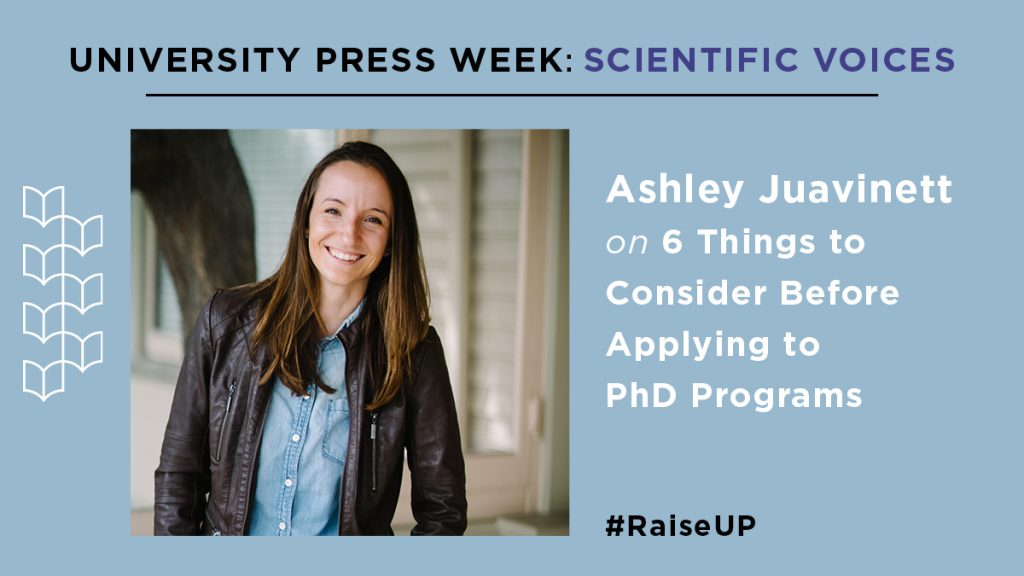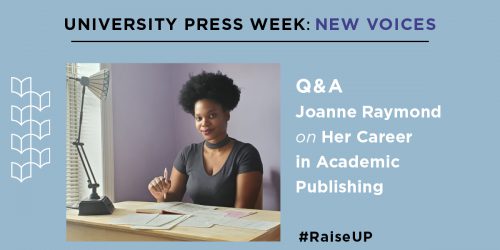6 Things to Consider Before Applying to PhD Programs

“A wealth of practical wisdom and cordial wit fills this book. Every lab will want to have a bin-full ready for all, from undergraduates, to graduate students, postdocs, techs, and, yes, faculty. Juavinett has a faultless and streamlined take on the entire range of the neurosciences, as well as a winning insight into the convoluted social and ethical customs shaping lab life.”
~Patricia S. Churchland, Salk Institute and University of California, San Diego
It’s University Press Week 2020, and today’s theme is “Scientific Voices.” In this post Ashley Juavinett, author of the recently published book So You Want to Be a Neuroscientist?, offers some practical advice to those looking to pursue a PhD.
• • • • • •
It’s the season for PhD applications—and potentially the time to figure out whether a PhD is the right step for you. Regardless of whether a PhD has been on your mind for the past week or the past few years, here are a few things to consider as you decide on applying and begin to narrow down a list of schools.
Step 1. Do you know why you’re pursuing a PhD?
Not every career path requires a PhD, though it can open additional doors to different and/or higher-paying positions. Even if you don’t know exactly what you’d like to do when you graduate with your doctorate degree, you should be sure that at least a couple of your top options are paths that will require the PhD. Otherwise, it may make sense for you to get job experience rather than an additional degree.
Step 2. Is this the right time in your life to pursue a PhD?
Even if you’re sure that you would like to take the highest ivory road at some point, this may not necessarily be the right year for you. If you’re not feeling emotionally prepared for new challenges or if you’d rather not make the move to another city right now, you might choose to wait. It may never be the absolutely perfect time, but be sure there is a readiness in your soul for a bit of challenge and change.
Step 3. Where would you like to live for the next five years?
It’s not superficial to want to spend the next five to six years in a place where you’ll feel safe and empowered. Sure, a PhD is time-consuming, but you’ll also want to spend some time doing soul-enriching activities beyond your research. This is an especially important question for marginalized communities who may not feel welcome in certain parts of the world. As you’re looking at PhD programs, this can be your first filter.
Step 4. What kind of research would you like to do?
Many departments have a range of research labs, but they can often over- or underrepresent specific subfields. If you’re currently doing research, take a moment to consider whether or not you’d like to continue with your particular subfield (e.g., Parkinson’s disease), the techniques you’re using (e.g., calcium imaging), or both. In the transition to graduate school, it’s entirely possible to change both your subfield and the techniques you’re using. However, if you’d rather not start from scratch, you could consider switching to new experimental questions with the same techniques, or to new techniques that address similar experimental questions.
Step 5. Are there at least three faculty members you would be excited to work with?
After you’ve narrowed down your research interests a bit, take a look at the lists of faculty members on different department and program websites. You can also look through lab websites and try to get a sense of the lab culture. If you can identify three or more advisors you’d be excited to work with, and the institution is in a place you’d like to live, add it to the list! In most neuroscience programs, you’ll have an opportunity to rotate with several faculty members to see how you jive with their management style and lab culture.
Step 6. Make sure you’re applying to a range of programs.
Even for an extremely qualified applicant with more than a year of research experience and an impressive GPA, applying to graduate programs in STEM is competitive. It can be a bit of a numbers game—applying to more schools usually translates to landing more interviews. Most competitive applicants apply to at least five programs. Within your list, make sure that there are at least a few that are not extremely competitive (i.e, ranked top 10, or with acceptance rates of less than 10 percent). Many schools post their admissions rates on their websites, or can be found here.
If you do decide to apply, be sure to set aside some time in your schedule to work on your applications and personalize them (just slightly) for each program. Most importantly, be ready for your perfectly well-laid plans to change as you grow and your interests evolve. In the words of Winston Churchill, “Plans are of little importance, but planning is essential.”




